“Top 10″ Surprises from the Pluto Flyby
New Horizons' principal investigator describes the most amazing discoveries made when NASA's New Horizons spacecraft flew past Pluto last July.
It sounds like science fiction, but it's not: NASA's New Horizons mission explored the Pluto system last summer — and here's my "top 10" list of what's surprised me the most about the results so far. (By the way, I didn't order this list below in terms of my "surprise factor.")
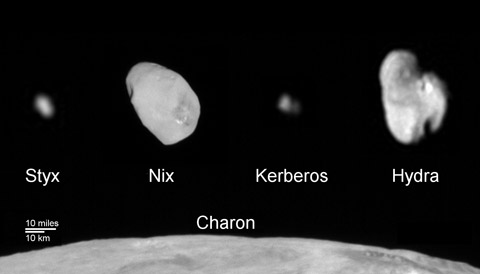
Pluto's five moons are shown to scale. Charon, 1,212 km (751 miles) across, is by far the largest. The others have irregular shapes.
NASA / JHU-APL / SWRI
NASA / JHU-APL / SWRI
No New Moons. I don't know about you, but I sure expected that we'd find more satellites circling Pluto. After finding four moons with successively deeper searches by the Hubble Space Telescope, I'm still amazed that our spacecraft searched with 20 to 30 times better sensitivity than Hubble and found nothing. Nada. Zip.
Pluto is Bigger Than Eris. Before the flyby, Pluto's diameter was somewhat uncertain, with most estimates being between 2,300 and 2,400 km (though some researchers put the lower limit down as far as 2,280 km). By comparison, we knew the diameter of Eris is 2,326 ±12 km, and much of the safe money was on Pluto being the second biggest body in the Kuiper Belt. But now, thanks to images from New Horizons, we've measured Pluto's diameter accurately — it's 2,374 ±6 km — making Pluto the clear king of the Kuiper Belt.
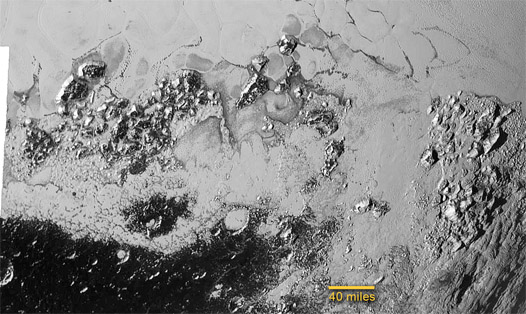
Two ranges of ice mountains on Pluto have been informally named Hillary Montes (left of center) and Norgay Montes (far right) for Sir Edmund Hillary and Tenzing Norgay, the first two humans to reach the summit of Mount Everest in 1953.
NASA / JHU-APL / SWRI
NASA / JHU-APL / SWRI
Tall Mountains. Actually, I'm not surprised that we found mountains — what surprises me is that there are so many of them and that some tower 3 to 4 km or higher in altitude. Nothing like that was seen by Voyager on Triton — a body about Pluto's size that once orbited in the Kuiper Belt. I think this just goes to show that we should expect lots of variety among the biggest bodies in the Kuiper Belt.
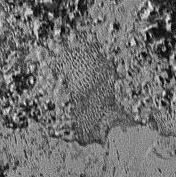
A small patch of surface near Pluto's equator exhibits what appear to be sets of dunes.
NASA / JHU-APL / SWRI
NASA / JHU-APL / SWRI
Dunes. There appear to be dune fields on Pluto's surface. This is completely surprising because Pluto's atmosphere isn't dense enough to create the wind to shape surface particles into dunes. My personal bet is that the dune fields (and some of the dendritic networks we see geologically as well) are telling us that Pluto's atmosphere was much thicker at some point (or points) in the past.
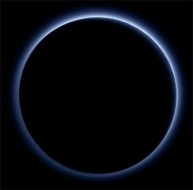
Sootlike haze particles in Pluto's thin atmosphere scatter light in a way that colors the sky blue.
NASA / JHU-APL / SWRI
NASA / JHU-APL / SWRI
Blue Skies. Pluto's atmospheric haze creates a blue sky at both sunrise and sunset, due to the same process (Rayleigh scattering) that makes Earth's skies blue. Years ago, we calculated whether Rayleigh scattering would be effective at Pluto's tenuous atmospheric pressure — just 0.00001 that on Earth — and we concluded there would be no significant blue-sky signature. So we never thought about hazes in the atmosphere creating a blue cast until we found it in our color imagery.
Pluto's Complexity. Before the flyby we knew Pluto would be complicated — spectroscopy had established that frozen nitrogen (N2), methane (CH4), and carbon monoxide (CO) coat parts of the surface; atmospheric pressure increased from the 1980s to the 2000s; albedo spots varied over time; there's a complex system of satellites; and more.
But honestly, the complexity and variety of Pluto's color, composition, and surface morphology are way beyond what I expected. We imagined Pluto to be "Triton on steroids," but what we got instead was another Mars. Some might even say we got "Mars on steroids" — if our growing notions of kaleidoscopic variations occurring over time pan out.
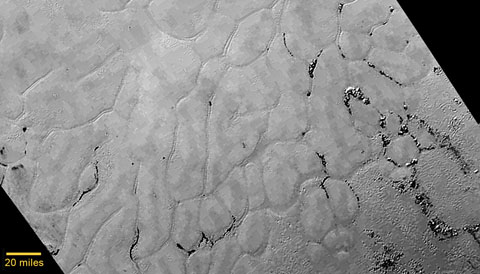
Informally named Sputnik Planum (Sputnik Plain), this vast, craterless plain appears to be divided into irregularly shaped segments rimmed by narrow troughs.
NASA / JHU-APL / SWRI
NASA / JHU-APL / SWRI
Current Activity. I expected that we'd find geysers, as occur on Triton, but so far we haven't. That's a small surprise in my book.
A much bigger one is the discovery of the 1,000-km-wide ice plain that we informally call Sputnik Planum. Amazingly, it has no detectable impact craters, which means it can't be any older than perhaps 100 million years and might be much younger.
That blows my mind! Somehow, 4 billion years after its formation, Pluto's internal engine is still active, creating vast landforms. How does it do that?
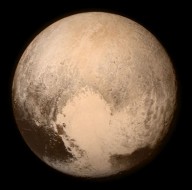
The large, bright “heart” in this view of Pluto has been informally named Tombaugh Regio.
NASA / JHU-APL / SwRI
NASA / JHU-APL / SwRI
Pluto Has a Heart! A vast, bright, heart-shaped region could be seen on Pluto by New Horizons from 70 million miles away. Given its prominence, our team gave it the informal moniker Tombaugh Regio, to honor of Pluto's discoverer, Clyde Tombaugh.
The surprise here isn't that such a feature exists — it's the public-relations bonanza it provided. Pluto's big "heart" emotionally connected all kinds of people who normally don't care at all about planetary exploration.
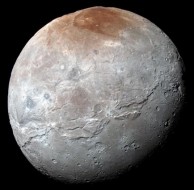
This false-color composite, created using blue, red, and near-infrared images, highlights the dramatic surface variations across Charon.
NASA / JHU-APL / SWRI
NASA / JHU-APL / SWRI
Charon's Complexity. Before the flyby, we thought Pluto's moon Charon had little color or compositional variation, virtually no brightness variations or clear surface markings, no detectable atmosphere, and no variability over time. Our telescopic scrutiny suggested it was a run-of-the-mill ice ball like a Uranian moons.
But high-resolution imaging by New Horizons has revealed a world with its own complex geological history, some new kinds of landforms (like mountains in dry moats), a dark polar stain that we simply don't understand, and varying crater densities and colors that are truly remarkable.
Charon is clearly among the most complex solid-surface worlds of the outer solar system, and that just wasn't expected. I know I am not alone on this one: Charon's complexity caught a lot of planetary scientists by surprise.
Flowing Glaciers. Who would have thought we'd have seen unambiguous evidence for glacial flow in Pluto's ices? Perhaps in retrospect this was something we should have expected. But when we discovered that telltale evidence in the very first New Horizons images sent to Earth after closest approach, it really struck home what a vibrant planet Pluto is.
If you've seen a crazy picture of me taken back in mid-July with my eyes bulging and mouth agape, Pluto's flowing glaciers was the discovery I was reacting to!
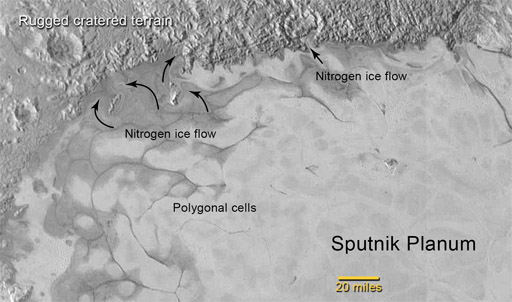
In the northwestern region of Pluto’s Sputnik Planum, swirl-shaped patterns of light and dark suggest that a surface layer of exotic ices has flowed around obstacles and into depressions, much like glaciers on Earth.
NASA / JHU-APL / SWRI
NASA / JHU-APL / SWRI
I noted at the beginning that this is my list so far. For the next 10 months or so, New Horizons will be transmitting data from the Pluto flyby virtually every day. Since most of the encounter's results are still stored on the spacecraft, including many high-resolution images, my "top 10" list will likely change as we learn more and more. I can't wait to see what other surprises are coming in the weeks and months ahead!

No comments:
Post a Comment